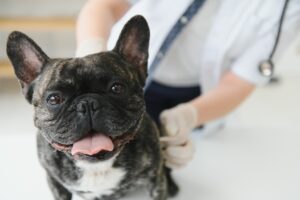Is your cherished companion scratching more than usual? Fleas are a common but avoidable issue that can cause significant discomfort for dogs and concern for their owners. Understanding how to detect, prevent, and treat fleas is essential for maintaining your pet’s overall health and well-being. Recognizing flea prevention and treatment is crucial for keeping your dog healthy and happy.
Understanding the Importance of Regular Flea Checks for Dog Health
As a pet owner, one of your primary responsibilities is ensuring your dog’s health and comfort. One often-overlooked aspect is the regular check for fleas. Fleas aren’t just a nuisance; they can lead to serious health problems for your pet. Regular flea checks are crucial for early detection and intervention, which can prevent these pesky parasites from becoming a significant problem. This guide will walk you through everything you need to know about fleas, from identifying the first signs to choosing the best treatment options. By the end, you’ll be well-equipped to keep your dog flea-free and healthy.
Signs and Symptoms of Fleas in Dogs
Recognizing the signs of fleas early can make a significant difference in your dog’s comfort and health. Here are some key behavioral and physical indicators that your dog might have fleas:
Behavioral Indicators
- Excessive Scratching: If your dog is constantly scratching, biting, or licking certain areas, it could be a sign of fleas.
- Restlessness: Fleas cause discomfort and can make your dog restless, leading to changes in sleeping patterns or increased anxiety.
- Head Shaking: Fleas in the ears can cause persistent shaking of the head.
Physical Indicators
- Flea Dirt: Small black specks on your dog’s skin or bedding, known as flea dirt, are a sure sign of fleas. These are flea droppings and can turn red when wet due to the digested blood.
- Red Bumps or Scabs: Flea bites can cause red, raised bumps on your dog’s skin, often leading to scabs if your dog scratches the area.
- Hair Loss: Continuous biting and scratching can lead to patches of hair loss, particularly around the base of the tail, neck, and hindquarters.
The Lifecycle of Fleas and Understanding Infestation
To effectively combat fleas, it’s essential to understand their lifecycle and how they infest both your pets and homes.
Flea Life Cycle
- Eggs: Adult fleas lay eggs on your dog, which then fall off into the environment, such as your home or yard.
- Larvae: These eggs hatch into larvae, which feed on organic debris, including flea dirt.
- Pupae: The larvae then spin cocoons and enter the pupal stage, where they develop into adult fleas.
- Adults: Adult fleas emerge from the pupae and seek out a host, typically your dog, to feed and continue the cycle.
Infestation Dynamics
- Environmental Contamination: Flea eggs, larvae, and pupae can be found in carpets, bedding, and furniture, making it crucial to treat both your pet and your home.
- Rapid Reproduction: A single flea can lay up to 50 eggs per day, leading to a rapid increase in flea populations if not promptly addressed.
Prevention Methods for Flea-Free Living

Preventing fleas is more manageable than dealing with an infestation. Here are some effective methods to keep fleas at bay:
Regular Grooming
- Frequent Brushing: Regularly brushing your dog with a flea comb can help detect and remove fleas early.
- Bathing: Use a flea shampoo during baths to kill any existing fleas and prevent new ones from settling.
Flea Treatments
- Topical Treatments: Products like Frontline or Advantage are applied directly to your dog’s skin and provide long-lasting protection against fleas.
- Oral Medications: Pills such as NexGard or Bravecto can kill fleas quickly and offer ongoing prevention.
- Collars: Flea collars like Seresto release a continuous dose of flea-repelling chemicals and can be effective for several months.
Household Cleaning Tips
- Vacuum Regularly: Vacuuming helps remove flea eggs and larvae from carpets, furniture, and cracks in floors.
- Wash Bedding: Frequently wash your dog’s bedding and any fabric they come into contact with in hot water.
- Treat the Home: Use flea sprays or foggers in your home to kill any remaining fleas and prevent reinfestation.
Treatment Options for Dogs with Fleas
If your dog already has fleas, prompt treatment is vital. Here are some options ranging from over-the-counter remedies to professional veterinary care:
Over-the-Counter Remedies
- Flea Shampoos: Specially formulated shampoos can kill fleas on contact. Follow up with consistent grooming and regular checks.
- Flea Sprays: These can be applied directly to your dog’s coat and help kill adult fleas instantly.
Veterinary Care
- Prescription Medications: Your vet can prescribe stronger treatments, such as NexGard or Simparica Trio, that may not be available over the counter.
- Injections: In severe infestations, your vet might recommend injections that kill fleas quickly and can prevent new fleas from hatching.
Natural Remedies
- Apple Cider Vinegar: Dilute with water and spray on your dog’s coat. While not as effective as chemical treatments, it can help repel fleas.
- Essential Oils: Oils like lavender and eucalyptus can be used to make homemade flea repellent sprays. Always consult with your vet before using essential oils, as some can be harmful to pets.
Impact of Fleas on Dog Health
Fleas are not just pesky insects; they are parasites that can have far-reaching consequences on the health and well-being of dogs. These tiny, wingless creatures survive by feeding on the blood of their hosts, causing a variety of problems ranging from mild irritation to severe health complications. Understanding the broader impact of fleas on your dog’s health is crucial in ensuring effective treatment and prevention.
Skin Problems
Fleas can cause various skin problems, from minor irritations to severe infections. Many dogs are allergic to flea saliva, which can cause severe itching and inflammation. Constant scratching and biting can lead to open sores, which can become infected if not treated promptly. Flea allergy dermatitis is another common issue, causing intense itching and discomfort.
Anemia
Severe flea infestations can lead to anemia, particularly in puppies and older dogs. Fleas feed on your dog’s blood, and a significant infestation can lead to a substantial loss of blood, causing weakness and lethargy.
Disease Transmission
Fleas can transmit various diseases, including tapeworms and Bartonella, the bacterium responsible for cat scratch fever in humans. These diseases can be serious, making flea prevention and treatment all the more critical.
How Truffle Paws Would Handle the Situation
At Truffle Paws, we understand the stress and concern that comes with a flea infestation. Here’s how we support you and your pet during such times:
- Swift Claims Processing: Our efficient claims process ensures you get reimbursed quickly, allowing you to handle vet bills without delay.
- Comprehensive Coverage: Our policies cover a wide range of treatments, from over-the-counter remedies to specialized veterinary care.
- Expert Support: Our team of pet care experts is always ready to provide guidance and support, helping you make the best choices for your pet’s health.
Encouraging Ongoing Flea Prevention
Fleas are a common but serious issue for dogs, requiring diligent care and preventive measures. By understanding the signs of fleas, their lifecycle, and effective prevention and treatment methods, you can keep your dog healthy and happy. Remember, early detection and intervention are key to preventing a small flea problem from becoming a significant infestation. Regular checks, proper grooming, and choosing the right insurance, like Truffle Paws, can make all the difference.Stay proactive, and your dog will thank you with endless love and happiness. Your cherished companion deserves a life free from the discomfort and health risks posed by fleas. For more tips and resources, sign up for our Truffle Bites newsletter on our website. Here’s to a flea-free and joyful life with your beloved pet!







